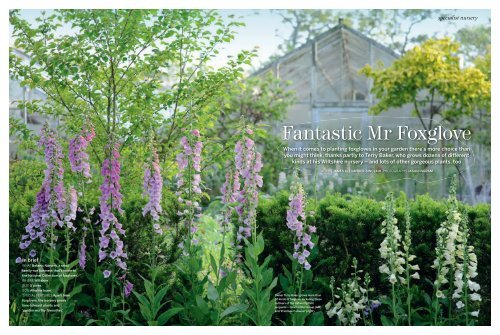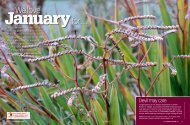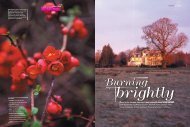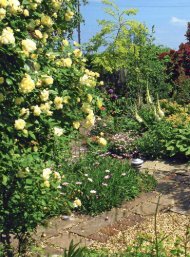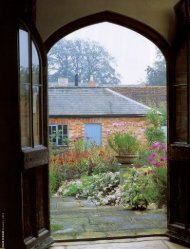Fantastic Mr Foxglove - James Alexander-Sinclair
Fantastic Mr Foxglove - James Alexander-Sinclair
Fantastic Mr Foxglove - James Alexander-Sinclair
You also want an ePaper? Increase the reach of your titles
YUMPU automatically turns print PDFs into web optimized ePapers that Google loves.
In brief<br />
WHAT Botanic Nursery, a small<br />
family-run business that’s home to<br />
the National Collection of foxgloves.<br />
WHERE Wiltshire.<br />
SIZE 5 acres.<br />
SOIL Alkaline loam.<br />
SPECIAL FEATURES Apart from<br />
foxgloves, the nursery grows<br />
lime-tolerant plants and<br />
‘garden-worthy favourites’.<br />
74<br />
specialist nursery<br />
<strong>Fantastic</strong> <strong>Mr</strong> <strong>Foxglove</strong><br />
When it comes to planting foxgloves in your garden there’s more choice than<br />
you might think, thanks partly to Terry Baker, who grows dozens of different<br />
kinds at his Wiltshire nursery – and lots of other gorgeous plants, too<br />
Owner Terry Baker grows more than<br />
30 kinds of foxglove, including these<br />
cultivars of the native Digitalis<br />
purpurea – Gloxinioides Group (left)<br />
and ‘Primrose Carousel’ (right).<br />
WORDS JAMES ALEXANDER-SINCLAIR PHOTOGRAPHS JASON INGRAM<br />
GI162_botanics_6jr.indd 74-75 5/5/10 09:19:09<br />
75
Iam sitting under an umbrella with the sun shining<br />
down, cup of tea in hand, surrounded by a jumble<br />
of different plants. There are pots of Brugmansia,<br />
scatterings of infant salvias, some exotic eryngiums, some<br />
spectacular and unusual shrubs and a tall and a glossily<br />
trunked Eucalyptus (grown from seed, incidentally).<br />
Outward appearances would indicate that we were<br />
sitting at our leisure in a well-stocked garden, but that would<br />
be misleading. Actually Terry Baker and I are in his nursery<br />
among crammed sale beds, brimming trolleys and, if I<br />
might say so, some slightly knackered old cold frames.<br />
There are two sorts of nursery: the clinically efficient,<br />
with plants laid out in neat rows and nary a weed in sight.<br />
The other sort is a jumble of plants arranged in a pattern<br />
known only to the nurseryman. The latter have the charm,<br />
while the former are much easier to navigate. The Botanic<br />
Nursery in Wiltshire manages to combine the two: it looks<br />
delightful while producing huge quantities of high-quality<br />
and interesting plants. As Terry explains, “We do a lot of<br />
shows so we need to churn out an awful lot of stock.”<br />
<strong>Foxglove</strong>s and other favourites<br />
The nursery is best known for its National Collection of<br />
Digitalis, some of which are pictured overleaf. These are<br />
at their best during <strong>Foxglove</strong> Week in the first week of<br />
June, but other foxgloves carry on much longer than that.<br />
Of 22 foxglove species, Terry has 20. Some are short,<br />
some tall, some evergreen; they are a pretty easy bunch to<br />
grow, though some are particularly good in shade, while<br />
others prefer hot, gritty soil or are best suited to rock<br />
gardens. Whichever way you shake it, there is a Digitalis here<br />
for every garden. Some are bred on the nursery but Terry has<br />
exacting standards. “If they don’t survive the winter well we<br />
reject them, no matter how attractive.” It’s a stern but<br />
ultimately sensible policy.<br />
Unlike some National Collection holders, however,<br />
Terry is not obsessed with foxgloves to the exclusion of other<br />
plants: he also grows lots of asters, hellebores and eryngiums.<br />
For him it is mostly about a heartfelt wish to grow “plants<br />
that gardeners want to grow”. The nursery also has the<br />
largest selection of lime-tolerant plants in the country:<br />
“I think it is good for the gardener to know that, if they<br />
have a limey soil, everything that they buy here will thrive.”<br />
Promiscuous passions<br />
Terry has been running this nursery with his wife Mary<br />
for 25 years. Once upon a time it must have been a walled<br />
garden for an estate but when they took it over it was a<br />
defunct market garden that had been rather overtaken by<br />
nature. Terry is the latest in a line of four generations of head<br />
gardeners, so that sort of thing leaves him undaunted.<br />
76<br />
1 <strong>Foxglove</strong>s look sensational in<br />
woodland plantings, borders and<br />
all sorts of other planting<br />
schemes; this one is backlit by<br />
the glowing orange-bronze<br />
young leaves of Cotinus ‘Grace’.<br />
For more foxgloves see overleaf.<br />
2 Apart from foxgloves, owner<br />
Terry Baker grows lots of<br />
what he calls ‘garden-worthy<br />
favourites’, including ox-eye<br />
daisies (Leucanthemum vulgare)<br />
and rich, red-brown Aquilegia<br />
‘Roundway Chocolate’.<br />
3 The double poppy Papaver<br />
somniferum ‘Black Paeony’<br />
is easy to grow from seed,<br />
according to Terry.<br />
4 The umbellifer Angelica<br />
syvestris ‘Purpurea’ is a biennial<br />
with purple-flushed stems and<br />
lime green flowers.<br />
5 Terry describes himself as<br />
a compulsive propagator –<br />
preparing hundreds of small<br />
plants for sale each year.<br />
6 Astrantia major ‘Hadspen<br />
Blood’ produces gem-like, deep<br />
red flowers from June to August.<br />
7 Summers are a busy time<br />
for Terry, who has to keep the<br />
nursery ticking over and take<br />
lorryloads of stock to a series of<br />
flower shows all over the country.<br />
1<br />
2<br />
3<br />
“<br />
If they don’t survive the “I<br />
winter well, we reject them,<br />
no matter how attractive<br />
4 5<br />
specialist nursery<br />
GI162_botanics_6jr.indd 76-77 5/5/10 09:19:12<br />
77<br />
7<br />
6
His first passion was for woody plants, in particular for<br />
those with unusual variegations, and the plantsman’s garden<br />
next to the nursery is packed with interesting shrubs; a<br />
Viburnum cylindricum, upon whose waxy leaves you can<br />
write, towers over a glowing Syringa emodi ‘Aurea’. The lawn,<br />
however, would give a green-keeper palpitations – it is kept<br />
shaggy for the wildflowers and to provide voles for the three<br />
resident owls. “We try to run the nursery as sustainably as<br />
possible, so have come to an affable arrangement with the<br />
wildlife,” says Terry. “Most are allowed free run of the place.”<br />
A prolific grower<br />
Terry is one of those nurserymen who just can’t stop<br />
growing stuff: he describes himself as a “compulsive<br />
propagator” and makes it all seem terribly easy and<br />
straightforward. There are greenhouses overflowing with<br />
oversized plants there “as propagating material”, and loads of<br />
seedlings. “We do most of the sowing in January: everything<br />
in a coir mixture, as we gave up peat about eight years ago.”<br />
The range is impressive: it needs to be, as Terry’s schedule<br />
includes pretty much every horticultural show in the<br />
country, from Malvern in spring to all the major RHS shows,<br />
county shows all over the place and even a couple in France.<br />
“Each show swallows a lorry-load of plants a day – if we’re<br />
doing well.” He is a glutton for this sort of thing and laments<br />
the passing of the RHS winter shows. “We used to meet some<br />
knowledgeable customers there and when the RHS stopped<br />
the shows their loss was a blow to many small nurseries.”<br />
Terry’s nursery may have shaggy edges but you can<br />
rest assured that he is a gardener with a mission to provide<br />
plants “that enrich other people’s gardens”. Place yourself,<br />
your plant choices and your garden in his hands: they are<br />
among the safest in Britain.<br />
USEFUL INFORMATION<br />
ADDRESS The Botanic Nursery, near Stonar School,<br />
Atworth, Wiltshire SN12 8HU.<br />
TEL 07850 328756 WEBSITE http://.botanicguru.co.uk<br />
OPEN Usually 9am-5pm in summer – please call to confirm.<br />
EVENTS See the nursery’s National Collection of foxgloves<br />
blooming during its <strong>Foxglove</strong> Week, 1-6 June.<br />
SHOWS Buy plants from Botanic Nursery at a series of major<br />
events this summer, including Gardener’s World Live in<br />
Birmingham (16-20 June), Cottesbrooke Plant Finders Fair in<br />
Northamptonshire (25-27 June – see page 10) and RHS<br />
Hampton Court Palace Flower Show in Surrey (6-11 July).<br />
<strong>James</strong> <strong>Alexander</strong>-<strong>Sinclair</strong> is a garden designer and<br />
broadcaster who co-presented TV coverage of the Chelsea<br />
Flower Show last month – see www.bbc.co.uk/gardening<br />
78<br />
12 fabulous<br />
foxgloves<br />
Terry Baker on some of the<br />
most distinguished Digitalis<br />
growing at his nursery<br />
1 Digitalis lutea – The small<br />
yellow foxglove grows wild in<br />
Mediterranean areas. 60cm<br />
spikes. Good in borders.<br />
2 Digitalis parviflora – This<br />
species, from northern Spain,<br />
has escaped the nursery and<br />
now grows wild in the village.<br />
Perennial; about 1m tall.<br />
3 Digitalis purpurea ‘Pam’s<br />
Choice’ – Our best selling plant.<br />
This is a strong new variety.<br />
About 1m high.<br />
4 Digitalis purpurea Excelsior<br />
Group – Really big trumpets that<br />
vary from white to brazen pink.<br />
up to 2m tall.<br />
5 Digitalis purpurea ‘Sutton’s<br />
Giant Primrose’ – This was<br />
thought lost until somebody<br />
found an envelope of seed in<br />
the back of an old bureau. 1.5m<br />
tall with large flowers.<br />
6 Digitalis purpurea ‘Sutton’s<br />
Apricot’ – It can change colour<br />
from seed but look for the dark<br />
veins on the back of the leaves to<br />
be sure. 1.5m high.<br />
7 Digitalis lanata – The woolly<br />
foxglove flowers after most of<br />
its relatives, in mid to late<br />
summer. 60cm tall.<br />
8 Digitalis ‘Glory of<br />
Roundway’ – A cross between<br />
D. x mertonensis and D. lutea.<br />
Sterile from seed. 70cm tall.<br />
9 Digitalis dubia – This species,<br />
from Mediterranean areas,<br />
flowers all summer. Greyish<br />
leaves. 1.5m high.<br />
10 Digitalis purpurea<br />
subsp. heywoodii – Pale yellow<br />
buds open into pure white<br />
flowers over silver leaves.<br />
Perennial. 75cm tall.<br />
11 Digitalis laevigata – This is<br />
used to stony mountainsides, so<br />
hates being crowded in a mixed<br />
border. Perennial. Height 1m.<br />
12 Digitalis obscura – the<br />
willow-leaved foxglove has lots<br />
of flowering stems. 45cm high.<br />
1<br />
5<br />
9<br />
specialist english nursery garden<br />
2 3 4<br />
6 7 8<br />
10 11 79 12<br />
GI162_botanics_6jr.indd 78-79 5/5/10 09:19:17


